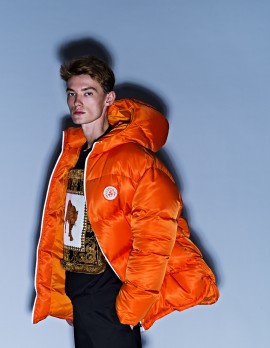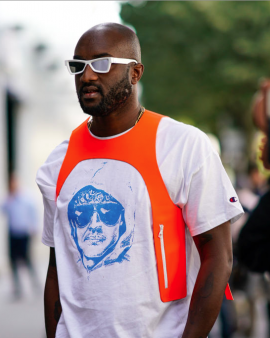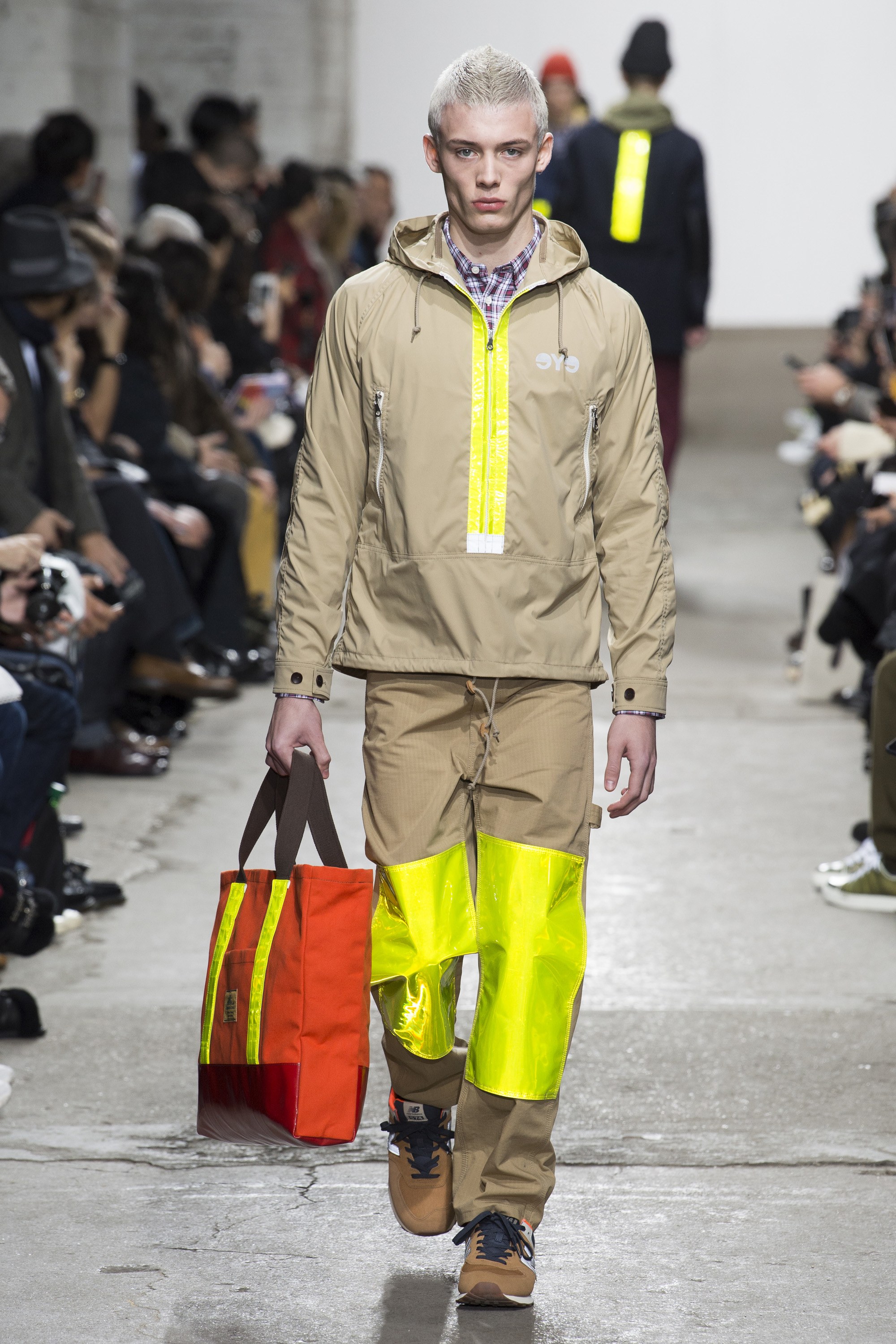N COME NEON
A sinistra, scatto di Federico Miletto per The Men Issue, Styling Giovanni de Ruvo. A destra, Virgil Abloh in uno scatto di streetstyle (fonte: GettyImages)
L’alfabeto della moda oggi chiama in causa la lettera N, per Neon.
Fu il fisico e chimico Georges Claude nel 1910 a presentare, al Grand Palais di Parigi, il primo tubo fluorescente a neon. Ci vollero però altri due anni perché nella stessa città apparisse la prima insegna luminosa al neon, sopra ad un piccolo negozio di barbiere. Da quel momento in poi questo tipo di illuminazione, associata ai suoi tipici e peculiari colori sgargianti, cambiò, totalmente e per sempre, l’aspetto delle città in tutto il globo, catturando gradualmente con le sue potenzialità l’attenzione di commercianti, artisti e pubblicitari, e col tempo anche del mondo della moda.
Per transizione, sono detti colori al neon quelli che conservano la stessa elettricità e vivacità dei tubi a fluorescenza; a differenza degli altri, la nostra percezione cambia, perché più stimolata: percepiamo prima il colore e poi la forma, non viceversa. Il colore è uno degli aspetti piu attraenti di ciò che vediamo; in particolar modo se vivido,
è determinante, di carattere, e se indossato diventa quasi suadente.
Artisti come Dan Flavin, Lucio Fontana, Stephen Antonakos e molti altri capirono in epoche differenti l’importanza del tubo (e della luce) al neon come potente mezzo di comunicazione, ed il fascino che lo stesso è in grado di suscitare nell’osservatore. Nel cinema, i colori a neon sono spesso comparsi in film futuristici come Matrix o Blade Runner, utilizzati per gli abiti o per le location cyber dell’era digitale.
Nella moda attuale, queste colorazioni luminose hanno iniziato a fare capolino da alcune stagioni, raggiungendo il culmine fino ad esplodere completamente nelle ultime collezioni, sia femminili che maschili. Prendono spunto dagli anni 80 e 90, dai rave psichedelici, dai “viaggi” da LSD, dalle ambientazioni dei party con musica Goa trance dove i colori neon facevano da padrone su tutto, dagli abiti, al make up, alle location, alle luci. Contrariamente a quello che si potrebbe pensare, è un tipo di trend che ha subito varie e diverse interpretazioni:
minimal, se utilizzato come unico pezzo, indossato magari sotto un abito scuro essenziale e rigoroso; acido, se associato a nylon, sport, con eventuali aggiunte di zip e stampe; divertente e sofisticato, se il capo in questione è realizzato in tulle o in seta.
Ce ne si accorge esaminando le ultime fatiche dei più grandi designer, di caso in caso. Prada su tutti esalta il fluo, spesso abbinato al nylon, nelle ultime collezioni sia femminili che maschili, nella sua Prada Linea Rossa; potete trovarne un esempio nella gallery delle collezioni fall/winter 18, insieme a: Comme des Garçons shirt, che ci propone la classica camicia indossata su un pantalone nero, ma in versione giallo fluo; Calvin Klein 205W39NYC, con la sua divisa da pompiere con tanto di dettagli catarifrangenti e stivali in pvc; Hermés, che ce lo mostra in veste elegante sotto un giubbotto in pelle, e Louis Vuitton, che ne fa una combo borsa in pelle/dolcevita destrutturato.
Nello scatto realizzato per The Men Issue da Federico Miletto, il modello indossa un piumino dal fit over arancio fluo abbinato ad una maglia stampata, entrambi della f/w 18/19 Versace, per un’attitude sportiva che non vuole passare inosservata; nello scatto di street style, vediamo il fashion designer Virgil Abloh indossare una sorta di gilet destrutturato arancio fluo con zip sul fianco, portato su una T-Shirt stampata. Solo per chi vuole davvero osare. Giovanni de Ruvo
The physicist and chemist Georges Claude presented, in 1910, at Grand Palais in Paris, the first neon fluorescent tube. It took two years to see in the same city the first luminous neon sign, on a little barber shop. From that moment on, this kind of lighting, associated to its typical and peculiar colors, changed, totally and forever, the appearance of cities all over the world, catching gradually with its potentials the attention of retailers, artists and advertisers, and during the decades, also of the fashion world. As a transition, neon colors are those that conserve the same electricity an brightness of fluorescent tubes; differently than with others, our perception changes, because it’s more stimulated: we perceive the color before the shape, not viceversa. Color is one of the most attractive features of what we see; especially if it’s bright, it’s decisive, strong, and if it’s worn it becomes almost persuasive. Artists like Dan Flavin, Lucio Fontana, Stephen Antonakos and many others understood in different decades the importance of the neon tube (and light) as a powerful means of communication, an the fascination that it’s able to raise in the observer. In movies, neon colors are often used in futuristic sceneries like Matrix or Blade Runner, for clothes or cyber locations of the digital era. In today fashion, those bright colors have started to peek out from few seasons ago, till completely exploding in the latest collections, in womenswear as well as in menswear. They draw inspiration from 80s and 90s, psychedelic raves, LSD “trips”, parties with Goa trance music, where neon colors held the stage from clothes, to make-up, to locations and lights. Contrary to what you can think, this is a trend that has undergone several different interpretations: minimal, if it’s a single piece, maybe worn under a dark essential and formal suit; acid, if associated with nylon, sport, with possible additions of zips and prints; funny and sophisticated, if the garment is made of tulle or silk. It is noticeable examining the latest efforts of the most important designers, case by case. Prada above all glorifies fluo, often matched with nylon, in Prada Linea Rossa; you can find an example in this gallery about fall/winter 18 collections, with others from: Comme des Garçons shirt, that suggest the classic shirt, worn with black trousers, but in fluo-yellow variation; Calvin Klein 205W39NYC, with its fireman uniform with di reflective details and pvc boots; Hermés, that shows it can be worn in elegant way under a leather jacket, and Louis Vuitton, that makes a combo leather bag/destructured turtleneck. In the picture by Federico Miletto for The Men Issue, the model wears an over fluo-orange puffy jacket matched with a printed sweater, both from Versace f/w 18/19, for a sporty attitude that likes to be noticed; in the street-style shot, we can see the fashion designer Virgil Abloh wearing a sort of destructured waistcoat over a printed T-shirt. Only for who wants to dare. Giovanni de Ruvo








